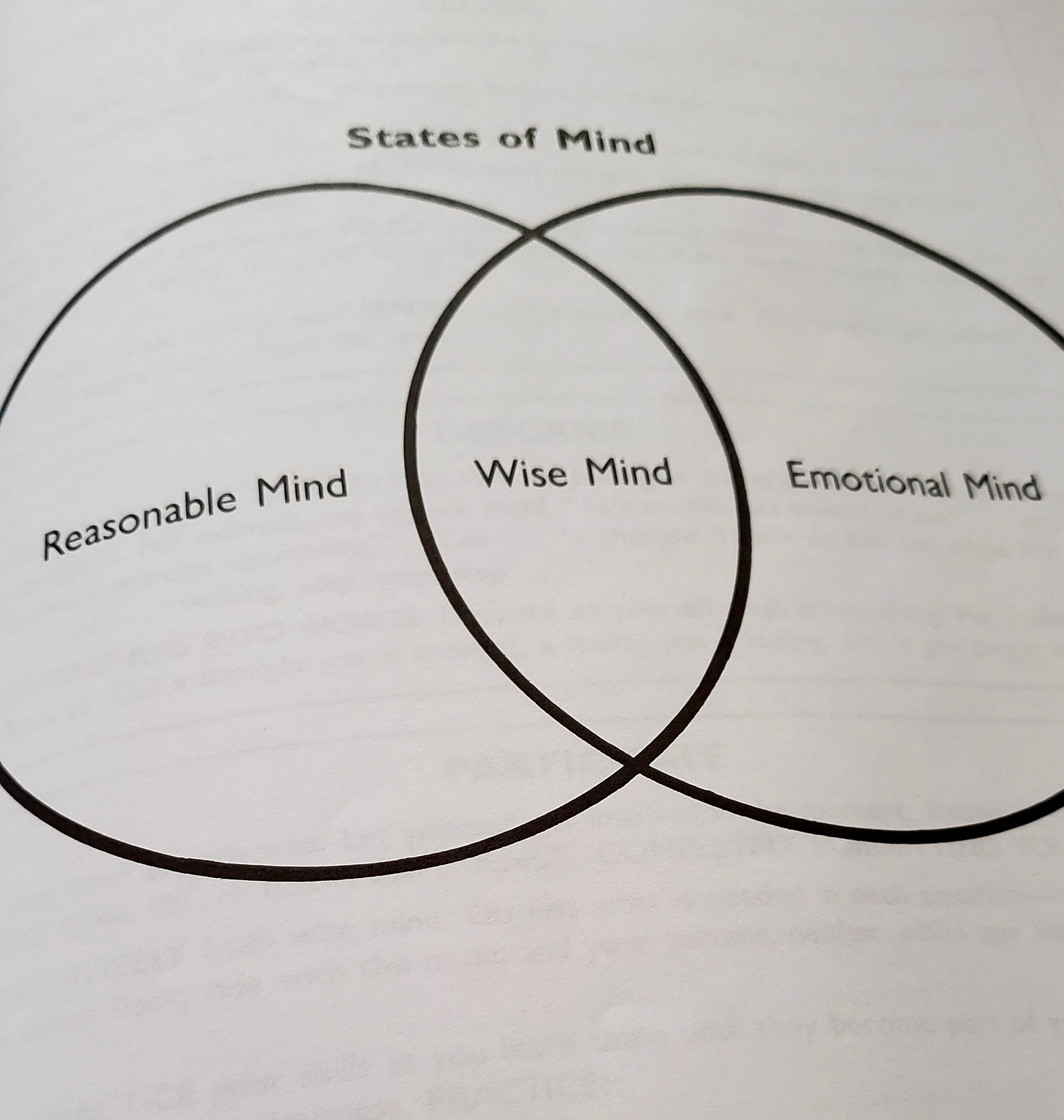As I mentioned several weeks ago in a brief discussion of how I myself use DBT skills most days in this current period of life we are living in, Dialectical Behavior Therapy can be broadly spoken of as the coming together of two seemingly opposite strategies: Acceptance and Change.
DBT is comprised of 4 Modules with a myriad of skills in each Module. There are two Acceptance Modules: Mindfulness and Distress Tolerance plus two Change Modules: Emotion Regulation and Interpersonal Effectiveness.
Consider those opposite strategies as the ends of a see-saw with the goal of using a skillful combination of the two in a balanced approach to living in the world.
Without exception, all of the clients I worked with loved the Acceptance Strategies and would have been happy to just focus on them. But, as we know, life demands more from us than simply tolerating. And so, benevolent dictator as I was accused of being, the clients were pushed, cajoled, and insisted upon to learn, then use, Change Strategies. Of course they were validated in their struggles because who, after all, doesn’t think ‘life is unfair’ especially when one believes she/he is unique is getting the short end of the stick in life. Clients were told from the beginning that I would work as hard as they did in bringing them along…but they had to do the work because no one can save us but ourselves.
So let’s look at this core concept of the Mind:
Imagine we all have 3 states of mind (without exception):
Emotion Mind in which we are motivated by intense emotion (love, hate, fear, anxiety, disgust, etc.) Logic, reason and facts are difficult to access leading to impulsive decision-making, volatility in the moment, acting, speaking and doing without realizing the potential for long-term consequences. Who hasn’t been in Emotion Mind?
Reasonable Mind in which logic, facts and reason are in control. This is what we need to plan and evaluate. Just think about doing a jig-saw puzzle, following a pattern or assembling a piece from Ikea or any vendor who leaves the putting together aspect to you. Budgeting is another example. We need this state of mind but like Dr. Spock, we are not accessing our emotional needs our personal values nor the needs of others if we operate soley from that state.
Wise Mind is the state we strive to be in. It integrates the two previously defined states of mind so that we think, feel, and act from a balanced place. We definitely know when we are in it because it has a quiet and peaceful quality. It has been described as having an intuitive knowing.
As you can see, Wise Mind has a larger amount of Emotional Mind and Reasonable Mind on either side which means, it takes practice to reach it. There is absolutely no need to go on a mindfulness retreat, find a meditation teacher nor spend hours a day in sitting practice (as in Zen and Tibetan Buddhism both of which I practiced for years). This is not about devotion, spirituality, and enlightenment. You can forget about the financial costs for all of the above.
“ Wise Mind is getting to the heart of the matter. It is seeing and knowing something directly and clearly. It is grasping the whole picture when before only parts were understood. It is ‘feeling’ the right choice in a dilemma, when the feeling comes from deep within rather than from a current emotional state” as Dr. Linehan writes in the DBT Skills Training Manual.”
Here is an overview of 4 practices helpful in finding Wise Mind. I will list them and come back to the 3rd which is a series of skills you will learn.
Breathe in ‘wise’ breathe out ‘mind.’ Put yourself in a mindful position (this may be a meditative state while lying down, or sitting in a quiet space) As you breathe in, say the word wise silently to yourself, and as you breathe out say mind. Continue this pattern for as long as you want. Any practice will be helpful.
Ask your Wise Mind a question and listen for the answer. As you inhale, ask yourself a question, like “Should I move across the country?” or “What positive qualities do I have?” As you exhale, make sure to listen for the answer in your mind— don’t or speak it. Continue asking with each breath in, and listen each time you breathe out.
Practice core mindfulness skills. The What and How skills from DBT can also help synthesize Emotion and Reasonable Mind, allowing you to access Wise Mind. Each of these skills is actually a group of skills that focus on understanding our thoughts, feelings, and behaviors in response to our lives and the world around us.
Consider your current state of mind. Before making a major decision or reacting to someone or something, ask yourself “What state of mind am I in?” If you are feeling extremely strong emotions, that is a sign, you are probably in Emotion Mind. Waiting to decide or respond until you are in Wise Mind could lead to more positive interactions with others and an improved sense of self.
This is not about spirituality, finding a meditation teacher, going on a retreat nor sitting for hours as in the Zen and Tibetan traditions I have practiced in for years. No indeed, this is about accessing and responding to your inherent Wise Mind to attain a more well-balanced happier life in this crazy unpredictable world.
I realize this is going to be longer that I expected and there are “What Skills” and “How Skills” to teach you so I will stop for this week and leave you to consider what you have read thus far.
I will end by saying something off-topic which is that Spring has truly arrived in my part of the world and my most favorite bird has arrived…the beloved hummingbird, just off it’s many thousand miles north from winter quarters. I know I’ve said this before but if the precious darlings make it down and back, they will return to the same spot year after year.
A tornado watch is now in effect and already my deck umbrella flew off and went away to another yard, no mean feat given it’s size and heft. So, I’m off to batten down the hatches. Wish me luck.
Please enjoy Mary Oliver’s “Hummingbirds”.
“Hummingbirds
The female, and two chicks,
each no bigger than my thumb,
scattered,
shimmering
in their pale-green dresses;
then they rose, tiny fireworks,
into the leaves
and hovered;
then they sat down,
each one with dainty, charcoal feet –
each one on a slender branch –
and looked at me.
I had meant no harm,
I had simply
climbed the tree
for something to do
on a summer day,
not knowing they were there,
ready to burst the ledges
of their mossy nest
and to fly, for the first time,
in their sea-green helmets,
with brisk, metallic tails –
each tulled wing,
with every dollop of flight,
drawing a perfect wheel
across the air.
Then, with a series of jerks,
they paused in front of me
and, dark-eyed, stared –
as though I were a flower –
and then,
like three tosses of silvery water,
they were gone.
Alone,
in the crown of the tree,
I went to China,
I went to Prague;
I died, and was born in the spring;
I found you, and loved you, again.
Later the darkness fell
and the solid moon
like a white pond rose.
But I wasn’t in any hurry.
Likely I visted all
the shimmering, heart-stabbing
questions without answers
before I climbed down.
***
Mary Oliver
White Pine (1994)







Such an interesting read thank you Frances xxx
Thank you for embarking on this series; your writing is so clear and the steps inviting and (relatively) easy to practice. Your term "benevolent dictator" reminds me of a gestalt therapist who uses the term "belligerent compassion".